Cyber-Crime and Cyber Espionage: Threats and Mitigation Strategies
VerifiedAdded on 2020/02/24
|13
|3229
|212
Report
AI Summary
This report delves into the critical topics of cyber-crime and cyber-espionage, highlighting their growing intensity and impact on individuals and organizations. It explores the structures, drivers, and economic aspects of cyber-crime, including various types such as crimes targeting computer systems and those using computers to facilitate other criminal activities. The report also examines cyber-espionage, detailing its methods, motivations, and the ways nations and states are affected. Through specific examples of cyber-attacks, the report underscores the severity of these threats and proposes preventive measures to protect personal information and data. It covers security threats like email threats, malware, and denial-of-service attacks, while suggesting preventive strategies such as spear phishing countermeasures and the importance of regular security assessments and updates. The report concludes with an analysis of the impact of cyber-crime and cyber espionage on individuals and the global economy, emphasizing the need for increased awareness and proactive security measures.
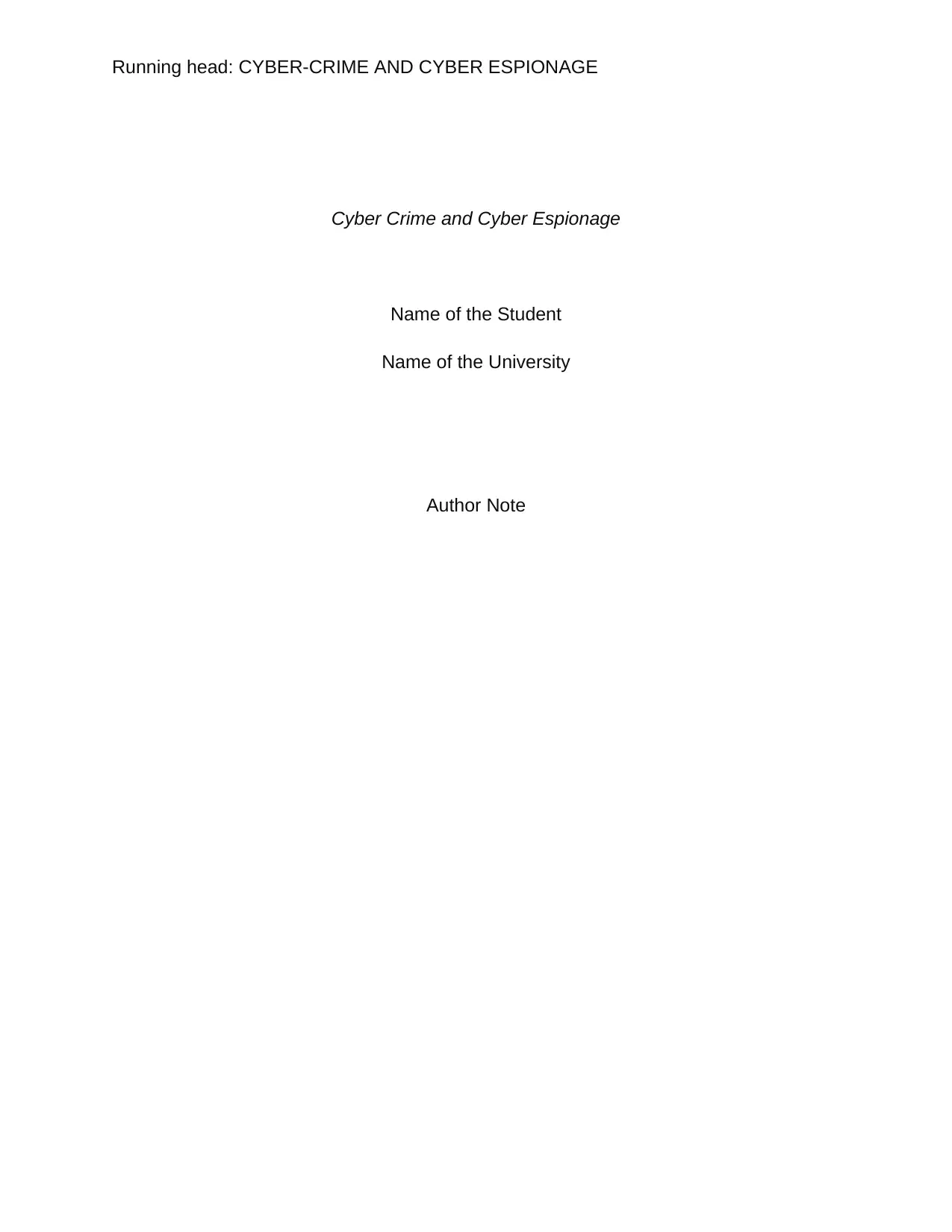
Running head: CYBER-CRIME AND CYBER ESPIONAGE
Cyber Crime and Cyber Espionage
Name of the Student
Name of the University
Author Note
Cyber Crime and Cyber Espionage
Name of the Student
Name of the University
Author Note
Paraphrase This Document
Need a fresh take? Get an instant paraphrase of this document with our AI Paraphraser
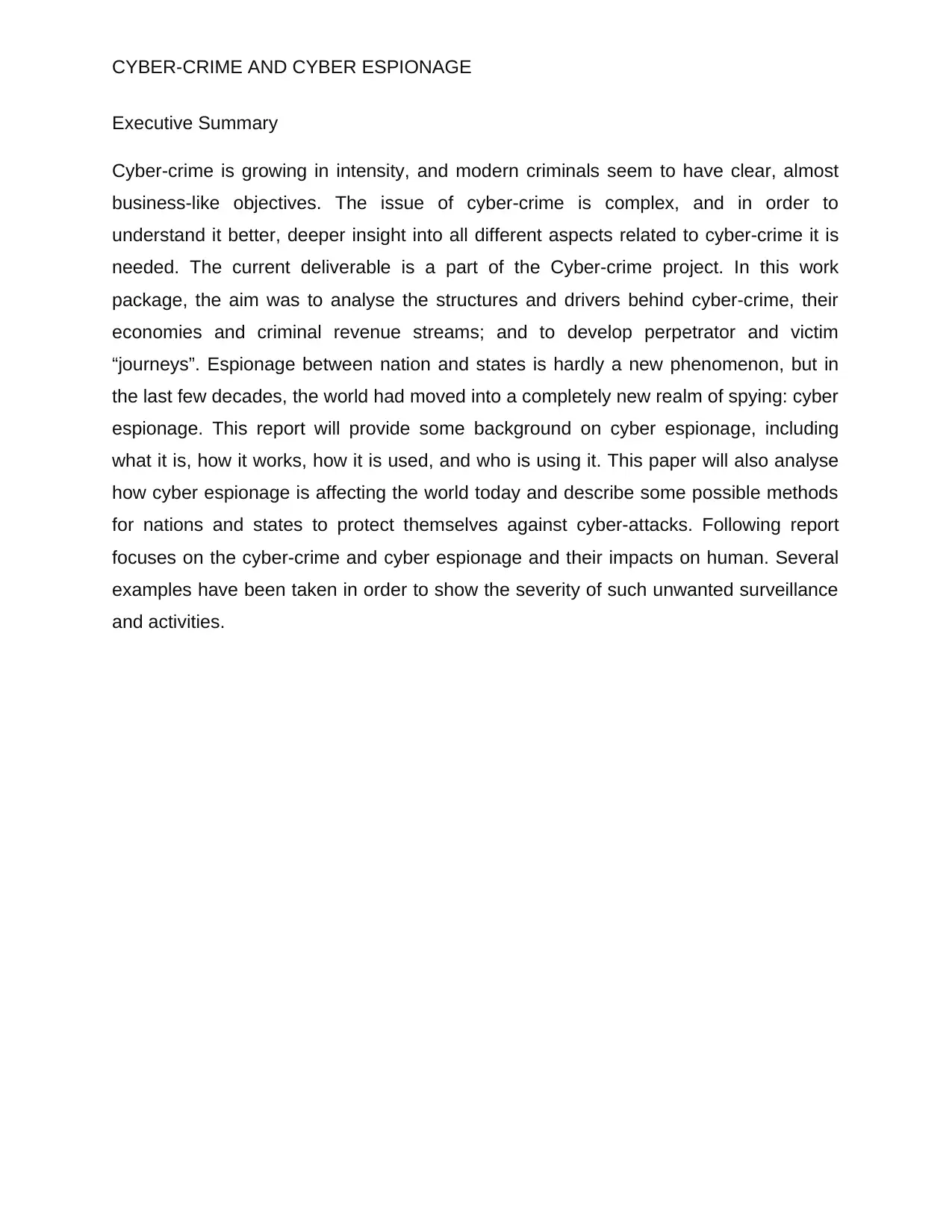
CYBER-CRIME AND CYBER ESPIONAGE
Executive Summary
Cyber-crime is growing in intensity, and modern criminals seem to have clear, almost
business-like objectives. The issue of cyber-crime is complex, and in order to
understand it better, deeper insight into all different aspects related to cyber-crime it is
needed. The current deliverable is a part of the Cyber-crime project. In this work
package, the aim was to analyse the structures and drivers behind cyber-crime, their
economies and criminal revenue streams; and to develop perpetrator and victim
“journeys”. Espionage between nation and states is hardly a new phenomenon, but in
the last few decades, the world had moved into a completely new realm of spying: cyber
espionage. This report will provide some background on cyber espionage, including
what it is, how it works, how it is used, and who is using it. This paper will also analyse
how cyber espionage is affecting the world today and describe some possible methods
for nations and states to protect themselves against cyber-attacks. Following report
focuses on the cyber-crime and cyber espionage and their impacts on human. Several
examples have been taken in order to show the severity of such unwanted surveillance
and activities.
Executive Summary
Cyber-crime is growing in intensity, and modern criminals seem to have clear, almost
business-like objectives. The issue of cyber-crime is complex, and in order to
understand it better, deeper insight into all different aspects related to cyber-crime it is
needed. The current deliverable is a part of the Cyber-crime project. In this work
package, the aim was to analyse the structures and drivers behind cyber-crime, their
economies and criminal revenue streams; and to develop perpetrator and victim
“journeys”. Espionage between nation and states is hardly a new phenomenon, but in
the last few decades, the world had moved into a completely new realm of spying: cyber
espionage. This report will provide some background on cyber espionage, including
what it is, how it works, how it is used, and who is using it. This paper will also analyse
how cyber espionage is affecting the world today and describe some possible methods
for nations and states to protect themselves against cyber-attacks. Following report
focuses on the cyber-crime and cyber espionage and their impacts on human. Several
examples have been taken in order to show the severity of such unwanted surveillance
and activities.
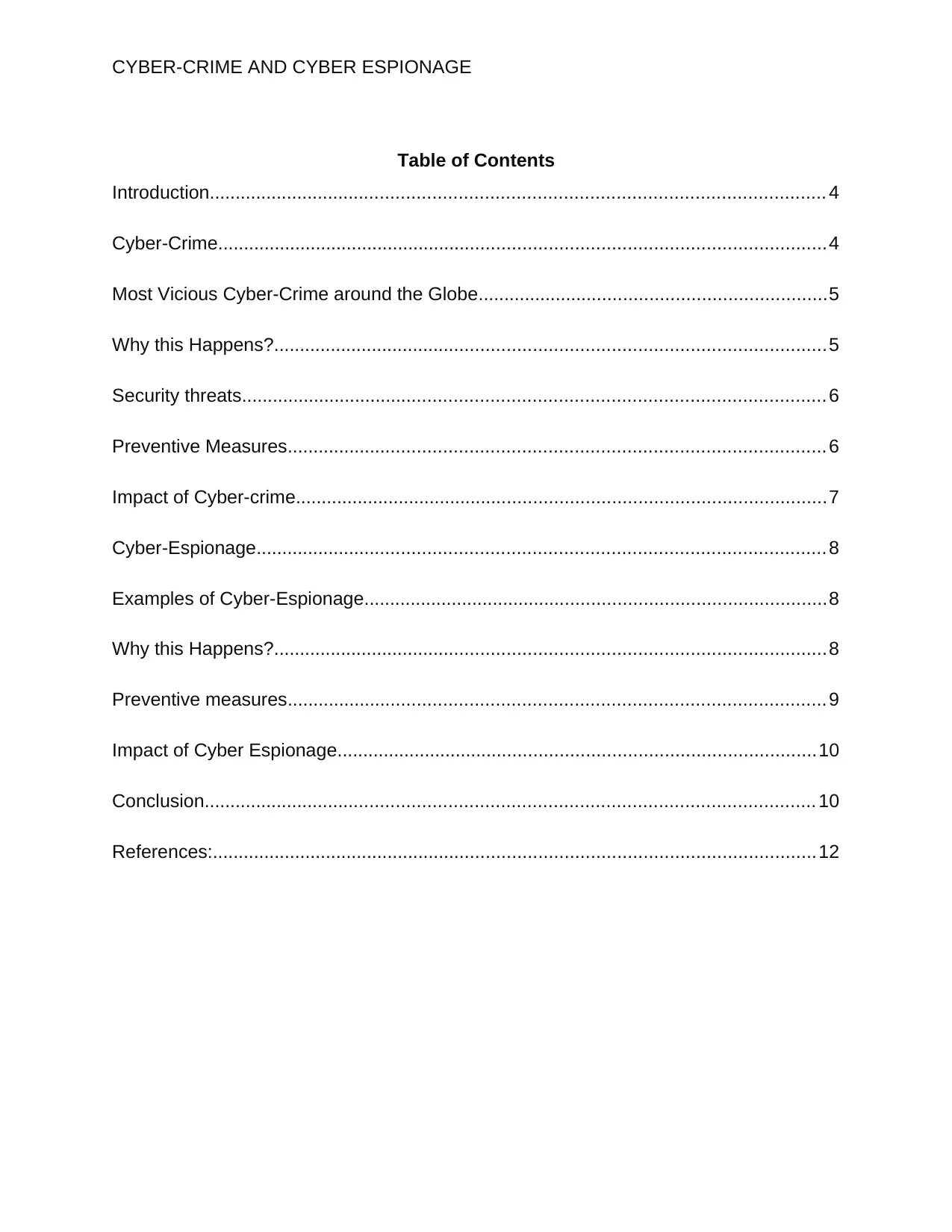
CYBER-CRIME AND CYBER ESPIONAGE
Table of Contents
Introduction...................................................................................................................... 4
Cyber-Crime.....................................................................................................................4
Most Vicious Cyber-Crime around the Globe...................................................................5
Why this Happens?..........................................................................................................5
Security threats................................................................................................................ 6
Preventive Measures....................................................................................................... 6
Impact of Cyber-crime......................................................................................................7
Cyber-Espionage............................................................................................................. 8
Examples of Cyber-Espionage.........................................................................................8
Why this Happens?..........................................................................................................8
Preventive measures....................................................................................................... 9
Impact of Cyber Espionage............................................................................................10
Conclusion..................................................................................................................... 10
References:....................................................................................................................12
Table of Contents
Introduction...................................................................................................................... 4
Cyber-Crime.....................................................................................................................4
Most Vicious Cyber-Crime around the Globe...................................................................5
Why this Happens?..........................................................................................................5
Security threats................................................................................................................ 6
Preventive Measures....................................................................................................... 6
Impact of Cyber-crime......................................................................................................7
Cyber-Espionage............................................................................................................. 8
Examples of Cyber-Espionage.........................................................................................8
Why this Happens?..........................................................................................................8
Preventive measures....................................................................................................... 9
Impact of Cyber Espionage............................................................................................10
Conclusion..................................................................................................................... 10
References:....................................................................................................................12
⊘ This is a preview!⊘
Do you want full access?
Subscribe today to unlock all pages.

Trusted by 1+ million students worldwide
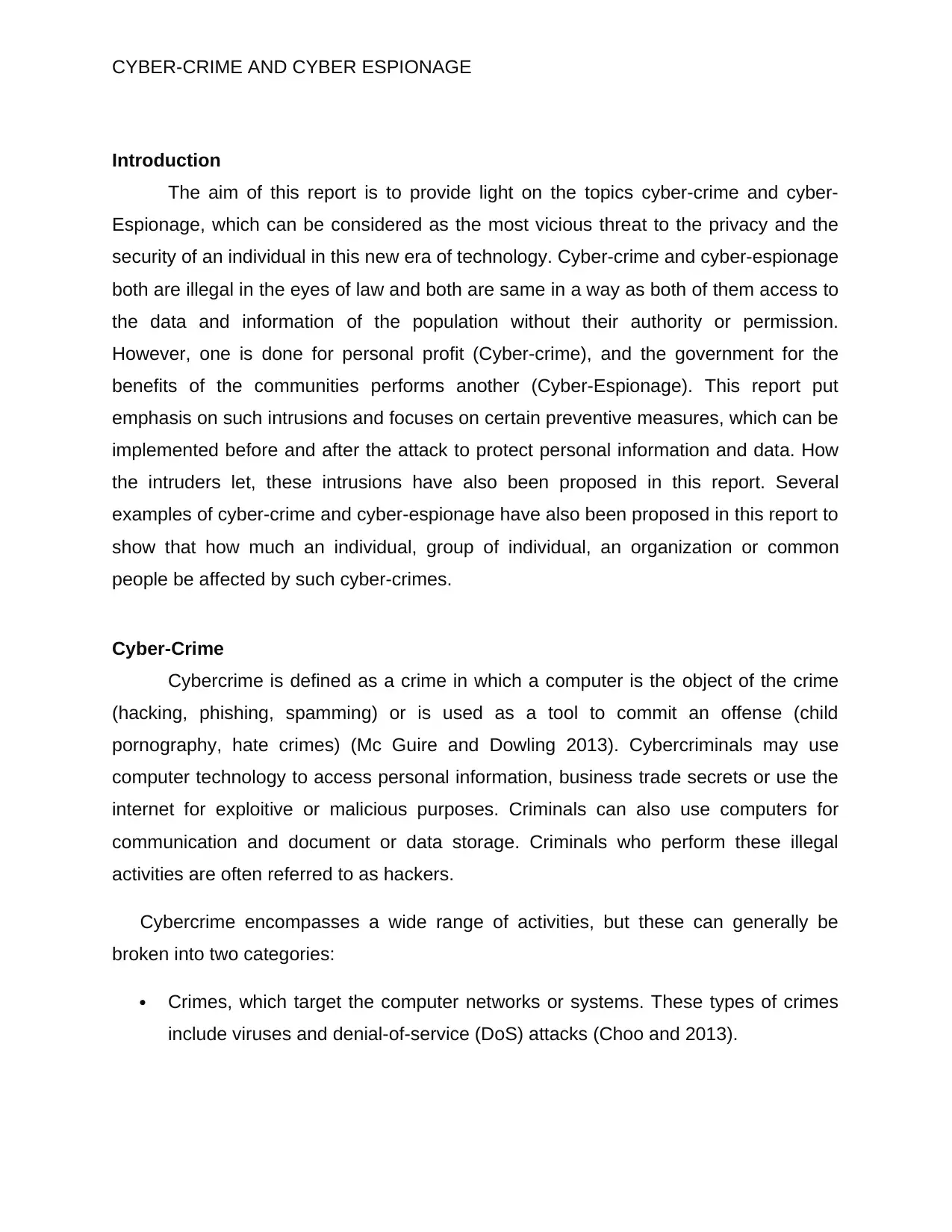
CYBER-CRIME AND CYBER ESPIONAGE
Introduction
The aim of this report is to provide light on the topics cyber-crime and cyber-
Espionage, which can be considered as the most vicious threat to the privacy and the
security of an individual in this new era of technology. Cyber-crime and cyber-espionage
both are illegal in the eyes of law and both are same in a way as both of them access to
the data and information of the population without their authority or permission.
However, one is done for personal profit (Cyber-crime), and the government for the
benefits of the communities performs another (Cyber-Espionage). This report put
emphasis on such intrusions and focuses on certain preventive measures, which can be
implemented before and after the attack to protect personal information and data. How
the intruders let, these intrusions have also been proposed in this report. Several
examples of cyber-crime and cyber-espionage have also been proposed in this report to
show that how much an individual, group of individual, an organization or common
people be affected by such cyber-crimes.
Cyber-Crime
Cybercrime is defined as a crime in which a computer is the object of the crime
(hacking, phishing, spamming) or is used as a tool to commit an offense (child
pornography, hate crimes) (Mc Guire and Dowling 2013). Cybercriminals may use
computer technology to access personal information, business trade secrets or use the
internet for exploitive or malicious purposes. Criminals can also use computers for
communication and document or data storage. Criminals who perform these illegal
activities are often referred to as hackers.
Cybercrime encompasses a wide range of activities, but these can generally be
broken into two categories:
Crimes, which target the computer networks or systems. These types of crimes
include viruses and denial-of-service (DoS) attacks (Choo and 2013).
Introduction
The aim of this report is to provide light on the topics cyber-crime and cyber-
Espionage, which can be considered as the most vicious threat to the privacy and the
security of an individual in this new era of technology. Cyber-crime and cyber-espionage
both are illegal in the eyes of law and both are same in a way as both of them access to
the data and information of the population without their authority or permission.
However, one is done for personal profit (Cyber-crime), and the government for the
benefits of the communities performs another (Cyber-Espionage). This report put
emphasis on such intrusions and focuses on certain preventive measures, which can be
implemented before and after the attack to protect personal information and data. How
the intruders let, these intrusions have also been proposed in this report. Several
examples of cyber-crime and cyber-espionage have also been proposed in this report to
show that how much an individual, group of individual, an organization or common
people be affected by such cyber-crimes.
Cyber-Crime
Cybercrime is defined as a crime in which a computer is the object of the crime
(hacking, phishing, spamming) or is used as a tool to commit an offense (child
pornography, hate crimes) (Mc Guire and Dowling 2013). Cybercriminals may use
computer technology to access personal information, business trade secrets or use the
internet for exploitive or malicious purposes. Criminals can also use computers for
communication and document or data storage. Criminals who perform these illegal
activities are often referred to as hackers.
Cybercrime encompasses a wide range of activities, but these can generally be
broken into two categories:
Crimes, which target the computer networks or systems. These types of crimes
include viruses and denial-of-service (DoS) attacks (Choo and 2013).
Paraphrase This Document
Need a fresh take? Get an instant paraphrase of this document with our AI Paraphraser
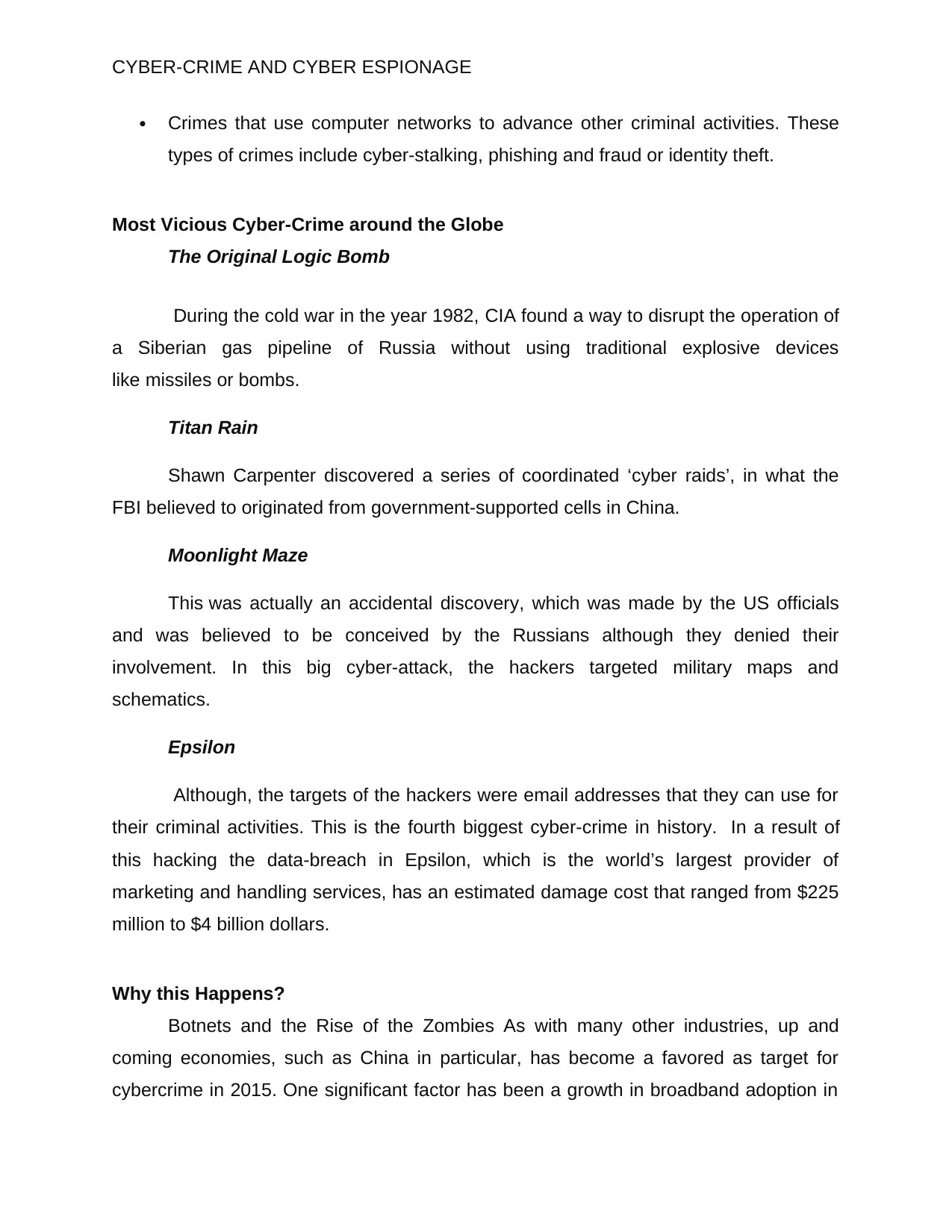
CYBER-CRIME AND CYBER ESPIONAGE
Crimes that use computer networks to advance other criminal activities. These
types of crimes include cyber-stalking, phishing and fraud or identity theft.
Most Vicious Cyber-Crime around the Globe
The Original Logic Bomb
During the cold war in the year 1982, CIA found a way to disrupt the operation of
a Siberian gas pipeline of Russia without using traditional explosive devices
like missiles or bombs.
Titan Rain
Shawn Carpenter discovered a series of coordinated ‘cyber raids’, in what the
FBI believed to originated from government-supported cells in China.
Moonlight Maze
This was actually an accidental discovery, which was made by the US officials
and was believed to be conceived by the Russians although they denied their
involvement. In this big cyber-attack, the hackers targeted military maps and
schematics.
Epsilon
Although, the targets of the hackers were email addresses that they can use for
their criminal activities. This is the fourth biggest cyber-crime in history. In a result of
this hacking the data-breach in Epsilon, which is the world’s largest provider of
marketing and handling services, has an estimated damage cost that ranged from $225
million to $4 billion dollars.
Why this Happens?
Botnets and the Rise of the Zombies As with many other industries, up and
coming economies, such as China in particular, has become a favored as target for
cybercrime in 2015. One significant factor has been a growth in broadband adoption in
Crimes that use computer networks to advance other criminal activities. These
types of crimes include cyber-stalking, phishing and fraud or identity theft.
Most Vicious Cyber-Crime around the Globe
The Original Logic Bomb
During the cold war in the year 1982, CIA found a way to disrupt the operation of
a Siberian gas pipeline of Russia without using traditional explosive devices
like missiles or bombs.
Titan Rain
Shawn Carpenter discovered a series of coordinated ‘cyber raids’, in what the
FBI believed to originated from government-supported cells in China.
Moonlight Maze
This was actually an accidental discovery, which was made by the US officials
and was believed to be conceived by the Russians although they denied their
involvement. In this big cyber-attack, the hackers targeted military maps and
schematics.
Epsilon
Although, the targets of the hackers were email addresses that they can use for
their criminal activities. This is the fourth biggest cyber-crime in history. In a result of
this hacking the data-breach in Epsilon, which is the world’s largest provider of
marketing and handling services, has an estimated damage cost that ranged from $225
million to $4 billion dollars.
Why this Happens?
Botnets and the Rise of the Zombies As with many other industries, up and
coming economies, such as China in particular, has become a favored as target for
cybercrime in 2015. One significant factor has been a growth in broadband adoption in
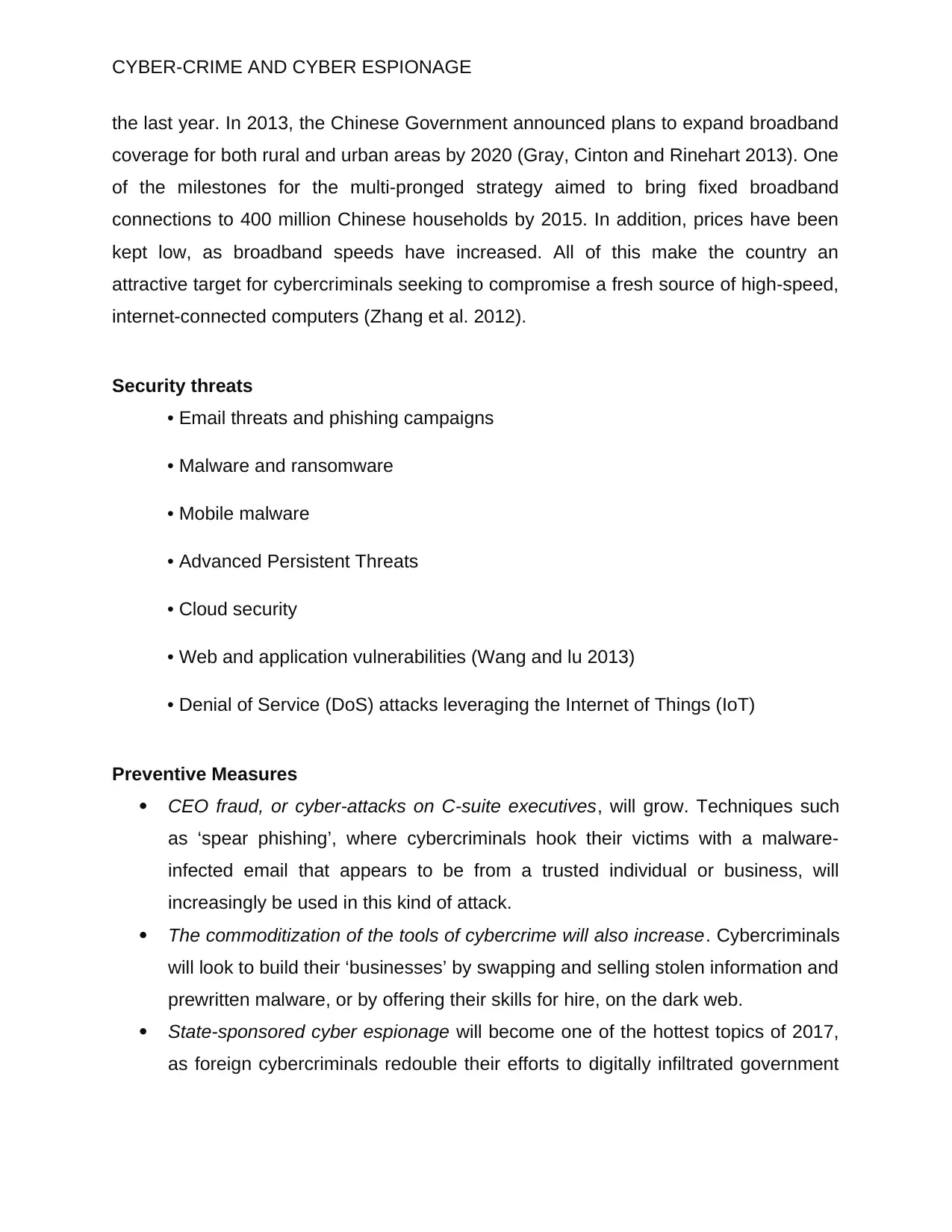
CYBER-CRIME AND CYBER ESPIONAGE
the last year. In 2013, the Chinese Government announced plans to expand broadband
coverage for both rural and urban areas by 2020 (Gray, Cinton and Rinehart 2013). One
of the milestones for the multi-pronged strategy aimed to bring fixed broadband
connections to 400 million Chinese households by 2015. In addition, prices have been
kept low, as broadband speeds have increased. All of this make the country an
attractive target for cybercriminals seeking to compromise a fresh source of high-speed,
internet-connected computers (Zhang et al. 2012).
Security threats
• Email threats and phishing campaigns
• Malware and ransomware
• Mobile malware
• Advanced Persistent Threats
• Cloud security
• Web and application vulnerabilities (Wang and lu 2013)
• Denial of Service (DoS) attacks leveraging the Internet of Things (IoT)
Preventive Measures
CEO fraud, or cyber-attacks on C-suite executives, will grow. Techniques such
as ‘spear phishing’, where cybercriminals hook their victims with a malware-
infected email that appears to be from a trusted individual or business, will
increasingly be used in this kind of attack.
The commoditization of the tools of cybercrime will also increase. Cybercriminals
will look to build their ‘businesses’ by swapping and selling stolen information and
prewritten malware, or by offering their skills for hire, on the dark web.
State-sponsored cyber espionage will become one of the hottest topics of 2017,
as foreign cybercriminals redouble their efforts to digitally infiltrated government
the last year. In 2013, the Chinese Government announced plans to expand broadband
coverage for both rural and urban areas by 2020 (Gray, Cinton and Rinehart 2013). One
of the milestones for the multi-pronged strategy aimed to bring fixed broadband
connections to 400 million Chinese households by 2015. In addition, prices have been
kept low, as broadband speeds have increased. All of this make the country an
attractive target for cybercriminals seeking to compromise a fresh source of high-speed,
internet-connected computers (Zhang et al. 2012).
Security threats
• Email threats and phishing campaigns
• Malware and ransomware
• Mobile malware
• Advanced Persistent Threats
• Cloud security
• Web and application vulnerabilities (Wang and lu 2013)
• Denial of Service (DoS) attacks leveraging the Internet of Things (IoT)
Preventive Measures
CEO fraud, or cyber-attacks on C-suite executives, will grow. Techniques such
as ‘spear phishing’, where cybercriminals hook their victims with a malware-
infected email that appears to be from a trusted individual or business, will
increasingly be used in this kind of attack.
The commoditization of the tools of cybercrime will also increase. Cybercriminals
will look to build their ‘businesses’ by swapping and selling stolen information and
prewritten malware, or by offering their skills for hire, on the dark web.
State-sponsored cyber espionage will become one of the hottest topics of 2017,
as foreign cybercriminals redouble their efforts to digitally infiltrated government
⊘ This is a preview!⊘
Do you want full access?
Subscribe today to unlock all pages.

Trusted by 1+ million students worldwide
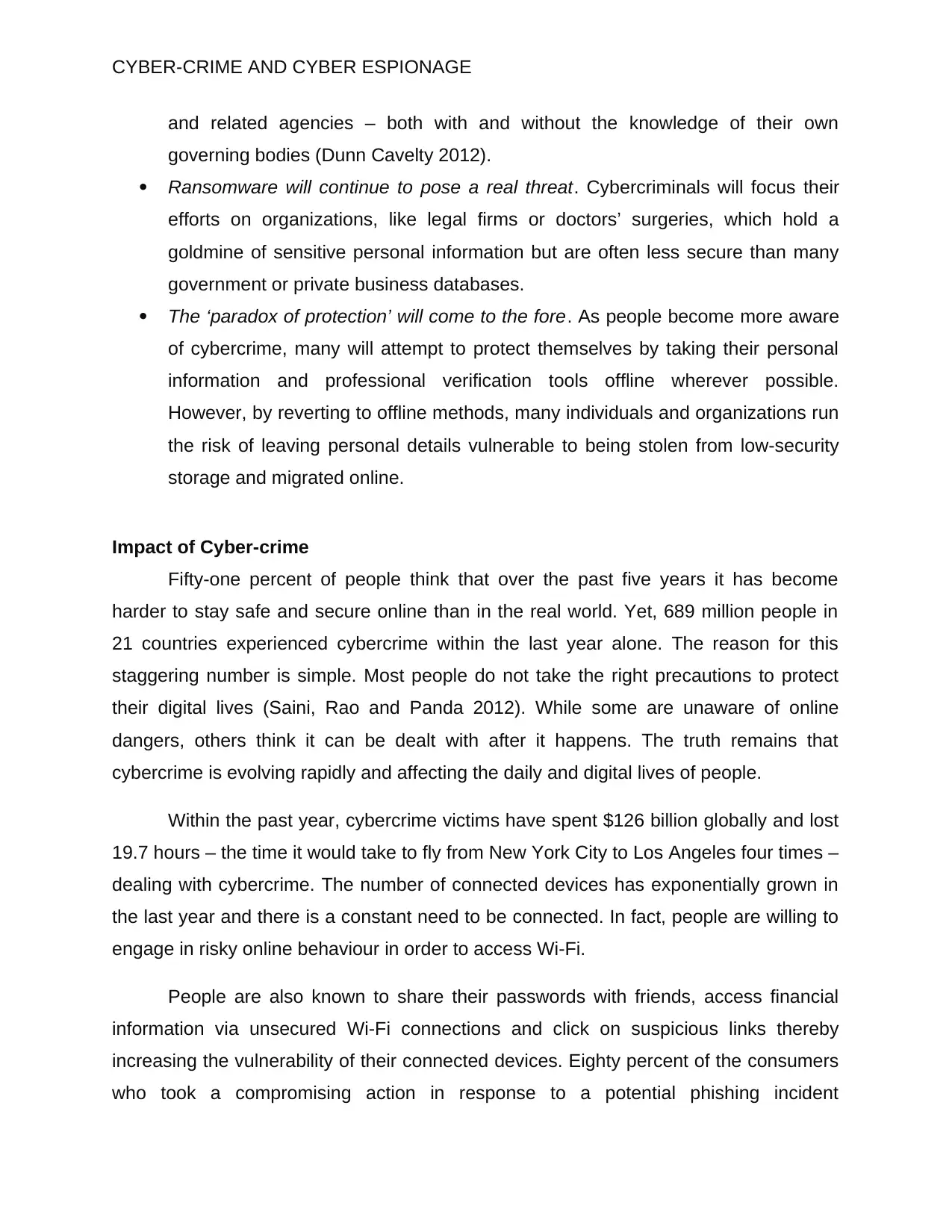
CYBER-CRIME AND CYBER ESPIONAGE
and related agencies – both with and without the knowledge of their own
governing bodies (Dunn Cavelty 2012).
Ransomware will continue to pose a real threat. Cybercriminals will focus their
efforts on organizations, like legal firms or doctors’ surgeries, which hold a
goldmine of sensitive personal information but are often less secure than many
government or private business databases.
The ‘paradox of protection’ will come to the fore. As people become more aware
of cybercrime, many will attempt to protect themselves by taking their personal
information and professional verification tools offline wherever possible.
However, by reverting to offline methods, many individuals and organizations run
the risk of leaving personal details vulnerable to being stolen from low-security
storage and migrated online.
Impact of Cyber-crime
Fifty-one percent of people think that over the past five years it has become
harder to stay safe and secure online than in the real world. Yet, 689 million people in
21 countries experienced cybercrime within the last year alone. The reason for this
staggering number is simple. Most people do not take the right precautions to protect
their digital lives (Saini, Rao and Panda 2012). While some are unaware of online
dangers, others think it can be dealt with after it happens. The truth remains that
cybercrime is evolving rapidly and affecting the daily and digital lives of people.
Within the past year, cybercrime victims have spent $126 billion globally and lost
19.7 hours – the time it would take to fly from New York City to Los Angeles four times –
dealing with cybercrime. The number of connected devices has exponentially grown in
the last year and there is a constant need to be connected. In fact, people are willing to
engage in risky online behaviour in order to access Wi-Fi.
People are also known to share their passwords with friends, access financial
information via unsecured Wi-Fi connections and click on suspicious links thereby
increasing the vulnerability of their connected devices. Eighty percent of the consumers
who took a compromising action in response to a potential phishing incident
and related agencies – both with and without the knowledge of their own
governing bodies (Dunn Cavelty 2012).
Ransomware will continue to pose a real threat. Cybercriminals will focus their
efforts on organizations, like legal firms or doctors’ surgeries, which hold a
goldmine of sensitive personal information but are often less secure than many
government or private business databases.
The ‘paradox of protection’ will come to the fore. As people become more aware
of cybercrime, many will attempt to protect themselves by taking their personal
information and professional verification tools offline wherever possible.
However, by reverting to offline methods, many individuals and organizations run
the risk of leaving personal details vulnerable to being stolen from low-security
storage and migrated online.
Impact of Cyber-crime
Fifty-one percent of people think that over the past five years it has become
harder to stay safe and secure online than in the real world. Yet, 689 million people in
21 countries experienced cybercrime within the last year alone. The reason for this
staggering number is simple. Most people do not take the right precautions to protect
their digital lives (Saini, Rao and Panda 2012). While some are unaware of online
dangers, others think it can be dealt with after it happens. The truth remains that
cybercrime is evolving rapidly and affecting the daily and digital lives of people.
Within the past year, cybercrime victims have spent $126 billion globally and lost
19.7 hours – the time it would take to fly from New York City to Los Angeles four times –
dealing with cybercrime. The number of connected devices has exponentially grown in
the last year and there is a constant need to be connected. In fact, people are willing to
engage in risky online behaviour in order to access Wi-Fi.
People are also known to share their passwords with friends, access financial
information via unsecured Wi-Fi connections and click on suspicious links thereby
increasing the vulnerability of their connected devices. Eighty percent of the consumers
who took a compromising action in response to a potential phishing incident
Paraphrase This Document
Need a fresh take? Get an instant paraphrase of this document with our AI Paraphraser
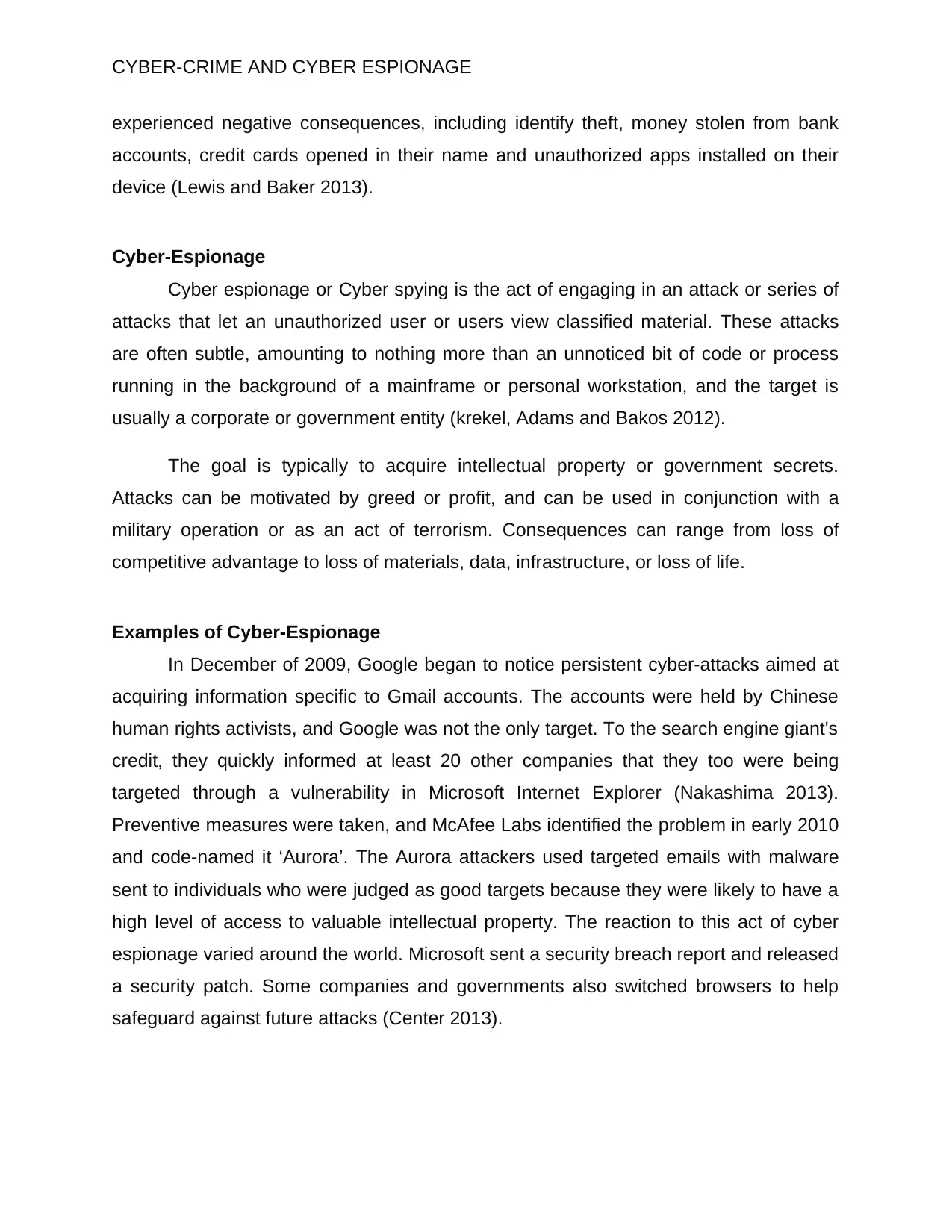
CYBER-CRIME AND CYBER ESPIONAGE
experienced negative consequences, including identify theft, money stolen from bank
accounts, credit cards opened in their name and unauthorized apps installed on their
device (Lewis and Baker 2013).
Cyber-Espionage
Cyber espionage or Cyber spying is the act of engaging in an attack or series of
attacks that let an unauthorized user or users view classified material. These attacks
are often subtle, amounting to nothing more than an unnoticed bit of code or process
running in the background of a mainframe or personal workstation, and the target is
usually a corporate or government entity (krekel, Adams and Bakos 2012).
The goal is typically to acquire intellectual property or government secrets.
Attacks can be motivated by greed or profit, and can be used in conjunction with a
military operation or as an act of terrorism. Consequences can range from loss of
competitive advantage to loss of materials, data, infrastructure, or loss of life.
Examples of Cyber-Espionage
In December of 2009, Google began to notice persistent cyber-attacks aimed at
acquiring information specific to Gmail accounts. The accounts were held by Chinese
human rights activists, and Google was not the only target. To the search engine giant's
credit, they quickly informed at least 20 other companies that they too were being
targeted through a vulnerability in Microsoft Internet Explorer (Nakashima 2013).
Preventive measures were taken, and McAfee Labs identified the problem in early 2010
and code-named it ‘Aurora’. The Aurora attackers used targeted emails with malware
sent to individuals who were judged as good targets because they were likely to have a
high level of access to valuable intellectual property. The reaction to this act of cyber
espionage varied around the world. Microsoft sent a security breach report and released
a security patch. Some companies and governments also switched browsers to help
safeguard against future attacks (Center 2013).
experienced negative consequences, including identify theft, money stolen from bank
accounts, credit cards opened in their name and unauthorized apps installed on their
device (Lewis and Baker 2013).
Cyber-Espionage
Cyber espionage or Cyber spying is the act of engaging in an attack or series of
attacks that let an unauthorized user or users view classified material. These attacks
are often subtle, amounting to nothing more than an unnoticed bit of code or process
running in the background of a mainframe or personal workstation, and the target is
usually a corporate or government entity (krekel, Adams and Bakos 2012).
The goal is typically to acquire intellectual property or government secrets.
Attacks can be motivated by greed or profit, and can be used in conjunction with a
military operation or as an act of terrorism. Consequences can range from loss of
competitive advantage to loss of materials, data, infrastructure, or loss of life.
Examples of Cyber-Espionage
In December of 2009, Google began to notice persistent cyber-attacks aimed at
acquiring information specific to Gmail accounts. The accounts were held by Chinese
human rights activists, and Google was not the only target. To the search engine giant's
credit, they quickly informed at least 20 other companies that they too were being
targeted through a vulnerability in Microsoft Internet Explorer (Nakashima 2013).
Preventive measures were taken, and McAfee Labs identified the problem in early 2010
and code-named it ‘Aurora’. The Aurora attackers used targeted emails with malware
sent to individuals who were judged as good targets because they were likely to have a
high level of access to valuable intellectual property. The reaction to this act of cyber
espionage varied around the world. Microsoft sent a security breach report and released
a security patch. Some companies and governments also switched browsers to help
safeguard against future attacks (Center 2013).

CYBER-CRIME AND CYBER ESPIONAGE
Why this Happens?
For years, corporations have attempted to seek advantages by prying into the
business plans of their competitors. One tactic is to send in “faux” employees who
attempt to gain access to data or projects where new technology is being developed.
Technology provided an evolutionary path for this activity, and resulted in the birth of
cyber spying.
The faux employee is still a useful tactic, but now an unsecured workstation is far
more attractive. An individual can use a USB stick to upload a worm or virus in a matter
of seconds. The goal might be to identify and open a security portal or find an exploit
that can be targeted later (Fidler 2013).
Business websites can offer the same type of openings, and experienced
hackers can use a vulnerable website to execute an attack. Emails that appear to be
official may be sent to specific individuals with higher network privileges who could be
lured into clicking a link that downloads code to enable later attacks. This type of attack
is called spear phishing.
Modern browser software is comprised of thousands of lines of code. New lines
of code add new features as the software evolves. Sometimes new code, by chance or
oversight (or lack thereof) breaks little-known features or works at-odds with security
patches that have previously been effective. When a new feature or a new piece of
software hits the market, it is analysed, dissected, and backward-engineered by
countless individuals and interested parties around the world.
Preventive measures
While no way is guaranteed to eliminate all attacks, it’s usually recommended to
companies and other organizations that they assess current security and procedures,
evaluate risks and develop a security policy or policies that help address vulnerabilities.
It may also be wise to define daily procedures and establish a response plan when an
attack is detected.
Why this Happens?
For years, corporations have attempted to seek advantages by prying into the
business plans of their competitors. One tactic is to send in “faux” employees who
attempt to gain access to data or projects where new technology is being developed.
Technology provided an evolutionary path for this activity, and resulted in the birth of
cyber spying.
The faux employee is still a useful tactic, but now an unsecured workstation is far
more attractive. An individual can use a USB stick to upload a worm or virus in a matter
of seconds. The goal might be to identify and open a security portal or find an exploit
that can be targeted later (Fidler 2013).
Business websites can offer the same type of openings, and experienced
hackers can use a vulnerable website to execute an attack. Emails that appear to be
official may be sent to specific individuals with higher network privileges who could be
lured into clicking a link that downloads code to enable later attacks. This type of attack
is called spear phishing.
Modern browser software is comprised of thousands of lines of code. New lines
of code add new features as the software evolves. Sometimes new code, by chance or
oversight (or lack thereof) breaks little-known features or works at-odds with security
patches that have previously been effective. When a new feature or a new piece of
software hits the market, it is analysed, dissected, and backward-engineered by
countless individuals and interested parties around the world.
Preventive measures
While no way is guaranteed to eliminate all attacks, it’s usually recommended to
companies and other organizations that they assess current security and procedures,
evaluate risks and develop a security policy or policies that help address vulnerabilities.
It may also be wise to define daily procedures and establish a response plan when an
attack is detected.
⊘ This is a preview!⊘
Do you want full access?
Subscribe today to unlock all pages.

Trusted by 1+ million students worldwide
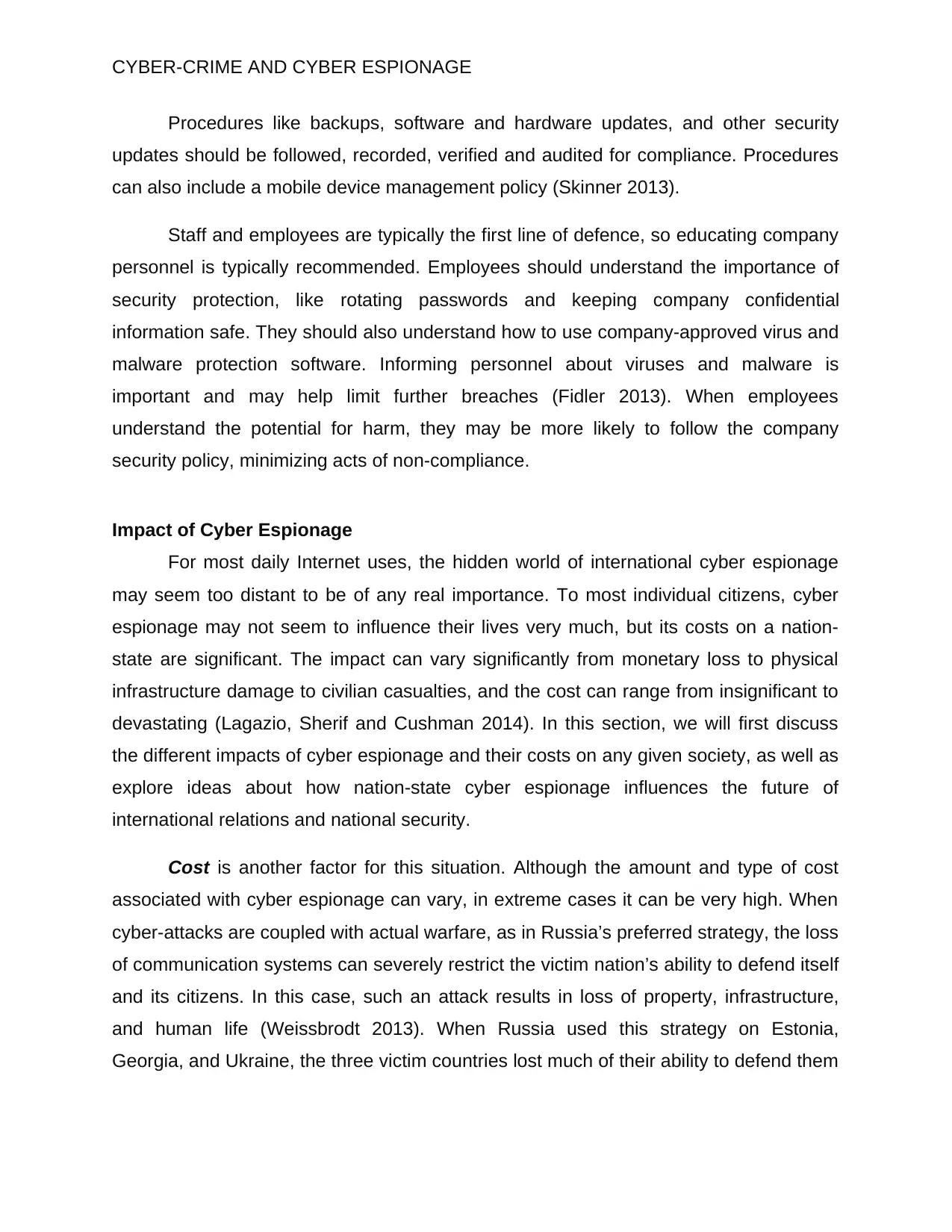
CYBER-CRIME AND CYBER ESPIONAGE
Procedures like backups, software and hardware updates, and other security
updates should be followed, recorded, verified and audited for compliance. Procedures
can also include a mobile device management policy (Skinner 2013).
Staff and employees are typically the first line of defence, so educating company
personnel is typically recommended. Employees should understand the importance of
security protection, like rotating passwords and keeping company confidential
information safe. They should also understand how to use company-approved virus and
malware protection software. Informing personnel about viruses and malware is
important and may help limit further breaches (Fidler 2013). When employees
understand the potential for harm, they may be more likely to follow the company
security policy, minimizing acts of non-compliance.
Impact of Cyber Espionage
For most daily Internet uses, the hidden world of international cyber espionage
may seem too distant to be of any real importance. To most individual citizens, cyber
espionage may not seem to influence their lives very much, but its costs on a nation-
state are significant. The impact can vary significantly from monetary loss to physical
infrastructure damage to civilian casualties, and the cost can range from insignificant to
devastating (Lagazio, Sherif and Cushman 2014). In this section, we will first discuss
the different impacts of cyber espionage and their costs on any given society, as well as
explore ideas about how nation-state cyber espionage influences the future of
international relations and national security.
Cost is another factor for this situation. Although the amount and type of cost
associated with cyber espionage can vary, in extreme cases it can be very high. When
cyber-attacks are coupled with actual warfare, as in Russia’s preferred strategy, the loss
of communication systems can severely restrict the victim nation’s ability to defend itself
and its citizens. In this case, such an attack results in loss of property, infrastructure,
and human life (Weissbrodt 2013). When Russia used this strategy on Estonia,
Georgia, and Ukraine, the three victim countries lost much of their ability to defend them
Procedures like backups, software and hardware updates, and other security
updates should be followed, recorded, verified and audited for compliance. Procedures
can also include a mobile device management policy (Skinner 2013).
Staff and employees are typically the first line of defence, so educating company
personnel is typically recommended. Employees should understand the importance of
security protection, like rotating passwords and keeping company confidential
information safe. They should also understand how to use company-approved virus and
malware protection software. Informing personnel about viruses and malware is
important and may help limit further breaches (Fidler 2013). When employees
understand the potential for harm, they may be more likely to follow the company
security policy, minimizing acts of non-compliance.
Impact of Cyber Espionage
For most daily Internet uses, the hidden world of international cyber espionage
may seem too distant to be of any real importance. To most individual citizens, cyber
espionage may not seem to influence their lives very much, but its costs on a nation-
state are significant. The impact can vary significantly from monetary loss to physical
infrastructure damage to civilian casualties, and the cost can range from insignificant to
devastating (Lagazio, Sherif and Cushman 2014). In this section, we will first discuss
the different impacts of cyber espionage and their costs on any given society, as well as
explore ideas about how nation-state cyber espionage influences the future of
international relations and national security.
Cost is another factor for this situation. Although the amount and type of cost
associated with cyber espionage can vary, in extreme cases it can be very high. When
cyber-attacks are coupled with actual warfare, as in Russia’s preferred strategy, the loss
of communication systems can severely restrict the victim nation’s ability to defend itself
and its citizens. In this case, such an attack results in loss of property, infrastructure,
and human life (Weissbrodt 2013). When Russia used this strategy on Estonia,
Georgia, and Ukraine, the three victim countries lost much of their ability to defend them
Paraphrase This Document
Need a fresh take? Get an instant paraphrase of this document with our AI Paraphraser
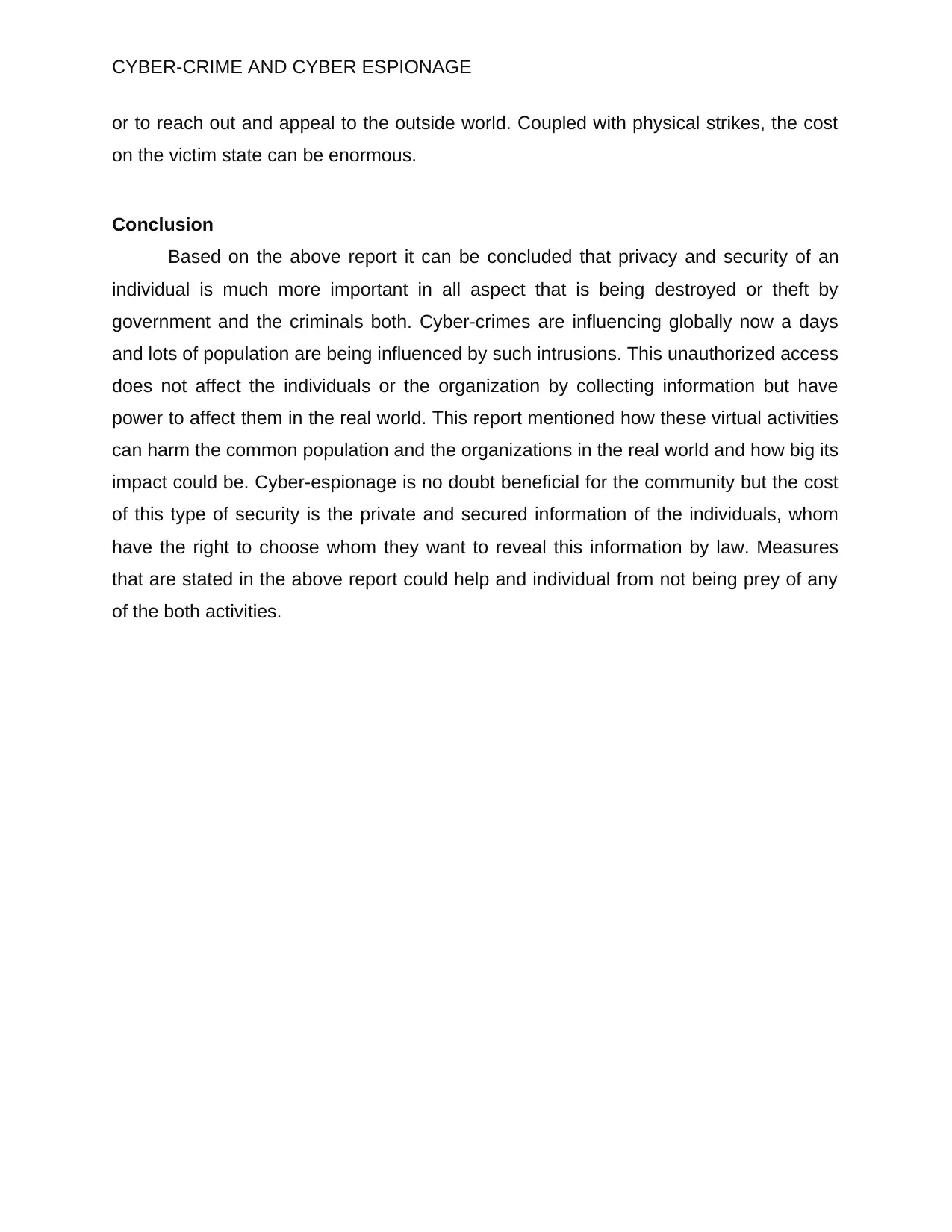
CYBER-CRIME AND CYBER ESPIONAGE
or to reach out and appeal to the outside world. Coupled with physical strikes, the cost
on the victim state can be enormous.
Conclusion
Based on the above report it can be concluded that privacy and security of an
individual is much more important in all aspect that is being destroyed or theft by
government and the criminals both. Cyber-crimes are influencing globally now a days
and lots of population are being influenced by such intrusions. This unauthorized access
does not affect the individuals or the organization by collecting information but have
power to affect them in the real world. This report mentioned how these virtual activities
can harm the common population and the organizations in the real world and how big its
impact could be. Cyber-espionage is no doubt beneficial for the community but the cost
of this type of security is the private and secured information of the individuals, whom
have the right to choose whom they want to reveal this information by law. Measures
that are stated in the above report could help and individual from not being prey of any
of the both activities.
or to reach out and appeal to the outside world. Coupled with physical strikes, the cost
on the victim state can be enormous.
Conclusion
Based on the above report it can be concluded that privacy and security of an
individual is much more important in all aspect that is being destroyed or theft by
government and the criminals both. Cyber-crimes are influencing globally now a days
and lots of population are being influenced by such intrusions. This unauthorized access
does not affect the individuals or the organization by collecting information but have
power to affect them in the real world. This report mentioned how these virtual activities
can harm the common population and the organizations in the real world and how big its
impact could be. Cyber-espionage is no doubt beneficial for the community but the cost
of this type of security is the private and secured information of the individuals, whom
have the right to choose whom they want to reveal this information by law. Measures
that are stated in the above report could help and individual from not being prey of any
of the both activities.
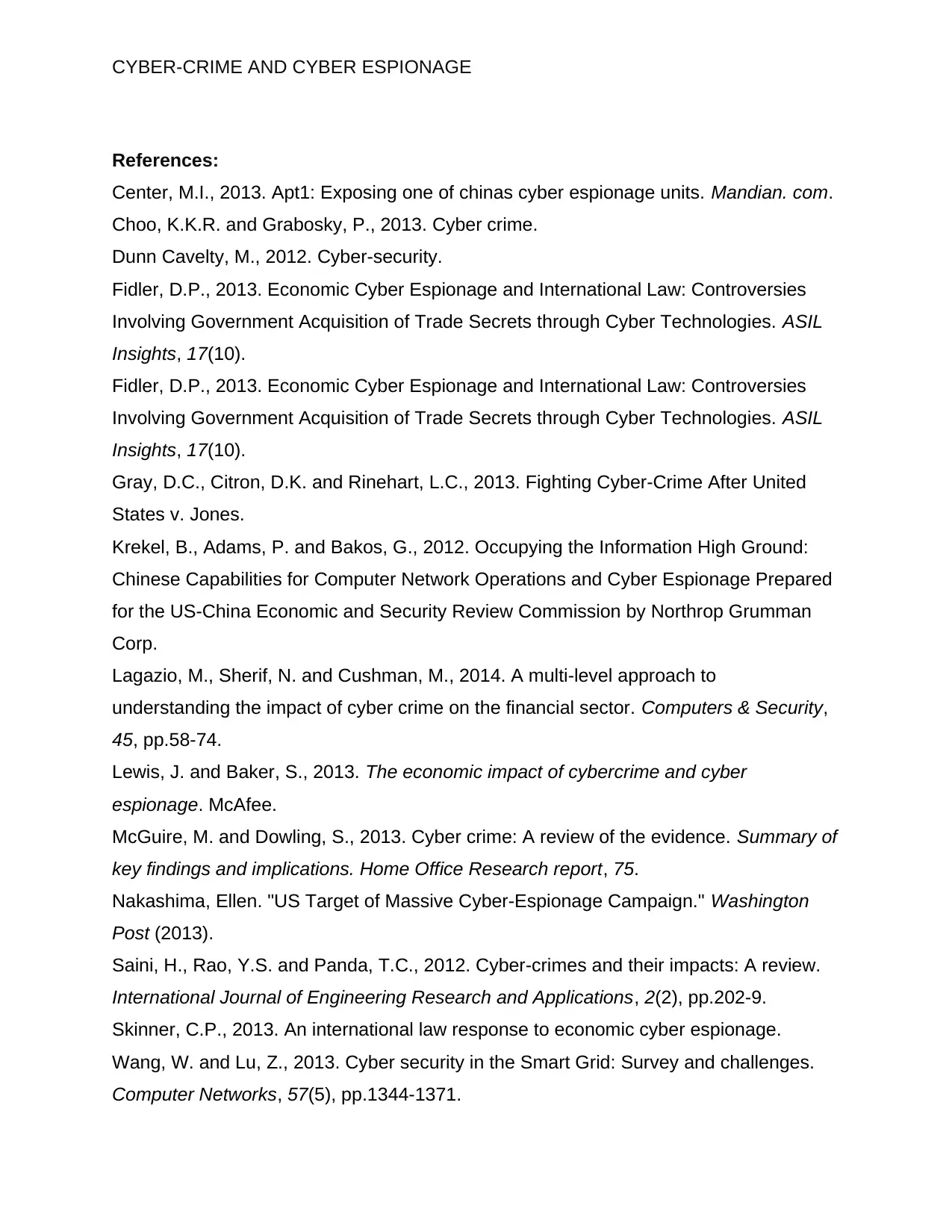
CYBER-CRIME AND CYBER ESPIONAGE
References:
Center, M.I., 2013. Apt1: Exposing one of chinas cyber espionage units. Mandian. com.
Choo, K.K.R. and Grabosky, P., 2013. Cyber crime.
Dunn Cavelty, M., 2012. Cyber-security.
Fidler, D.P., 2013. Economic Cyber Espionage and International Law: Controversies
Involving Government Acquisition of Trade Secrets through Cyber Technologies. ASIL
Insights, 17(10).
Fidler, D.P., 2013. Economic Cyber Espionage and International Law: Controversies
Involving Government Acquisition of Trade Secrets through Cyber Technologies. ASIL
Insights, 17(10).
Gray, D.C., Citron, D.K. and Rinehart, L.C., 2013. Fighting Cyber-Crime After United
States v. Jones.
Krekel, B., Adams, P. and Bakos, G., 2012. Occupying the Information High Ground:
Chinese Capabilities for Computer Network Operations and Cyber Espionage Prepared
for the US-China Economic and Security Review Commission by Northrop Grumman
Corp.
Lagazio, M., Sherif, N. and Cushman, M., 2014. A multi-level approach to
understanding the impact of cyber crime on the financial sector. Computers & Security,
45, pp.58-74.
Lewis, J. and Baker, S., 2013. The economic impact of cybercrime and cyber
espionage. McAfee.
McGuire, M. and Dowling, S., 2013. Cyber crime: A review of the evidence. Summary of
key findings and implications. Home Office Research report, 75.
Nakashima, Ellen. "US Target of Massive Cyber-Espionage Campaign." Washington
Post (2013).
Saini, H., Rao, Y.S. and Panda, T.C., 2012. Cyber-crimes and their impacts: A review.
International Journal of Engineering Research and Applications, 2(2), pp.202-9.
Skinner, C.P., 2013. An international law response to economic cyber espionage.
Wang, W. and Lu, Z., 2013. Cyber security in the Smart Grid: Survey and challenges.
Computer Networks, 57(5), pp.1344-1371.
References:
Center, M.I., 2013. Apt1: Exposing one of chinas cyber espionage units. Mandian. com.
Choo, K.K.R. and Grabosky, P., 2013. Cyber crime.
Dunn Cavelty, M., 2012. Cyber-security.
Fidler, D.P., 2013. Economic Cyber Espionage and International Law: Controversies
Involving Government Acquisition of Trade Secrets through Cyber Technologies. ASIL
Insights, 17(10).
Fidler, D.P., 2013. Economic Cyber Espionage and International Law: Controversies
Involving Government Acquisition of Trade Secrets through Cyber Technologies. ASIL
Insights, 17(10).
Gray, D.C., Citron, D.K. and Rinehart, L.C., 2013. Fighting Cyber-Crime After United
States v. Jones.
Krekel, B., Adams, P. and Bakos, G., 2012. Occupying the Information High Ground:
Chinese Capabilities for Computer Network Operations and Cyber Espionage Prepared
for the US-China Economic and Security Review Commission by Northrop Grumman
Corp.
Lagazio, M., Sherif, N. and Cushman, M., 2014. A multi-level approach to
understanding the impact of cyber crime on the financial sector. Computers & Security,
45, pp.58-74.
Lewis, J. and Baker, S., 2013. The economic impact of cybercrime and cyber
espionage. McAfee.
McGuire, M. and Dowling, S., 2013. Cyber crime: A review of the evidence. Summary of
key findings and implications. Home Office Research report, 75.
Nakashima, Ellen. "US Target of Massive Cyber-Espionage Campaign." Washington
Post (2013).
Saini, H., Rao, Y.S. and Panda, T.C., 2012. Cyber-crimes and their impacts: A review.
International Journal of Engineering Research and Applications, 2(2), pp.202-9.
Skinner, C.P., 2013. An international law response to economic cyber espionage.
Wang, W. and Lu, Z., 2013. Cyber security in the Smart Grid: Survey and challenges.
Computer Networks, 57(5), pp.1344-1371.
⊘ This is a preview!⊘
Do you want full access?
Subscribe today to unlock all pages.

Trusted by 1+ million students worldwide
1 out of 13
Related Documents
Your All-in-One AI-Powered Toolkit for Academic Success.
+13062052269
info@desklib.com
Available 24*7 on WhatsApp / Email
![[object Object]](/_next/static/media/star-bottom.7253800d.svg)
Unlock your academic potential
Copyright © 2020–2025 A2Z Services. All Rights Reserved. Developed and managed by ZUCOL.





